上海新世纪版英语六年级下册6BUnit1Lesson1U1L1同步讲义教案
沪教牛津版(三起点)六下_Unit 1 第1课时公开课教学设计 (1)

Unit 1 第1课时公开课课件课题:Unit 1 You and me一、学情分析小学六年级学生普遍拥有较好的英语听、说、读、写能力,正在进入青春期的他们既关注自己成长的变化,也对外部世界充满了兴趣,拥有探索的欲望,善于思考,也乐于实践。
生活在大城市的他们大部分来自五湖四海,对于城市与乡村的区别与变化发展有切身体验,所有这些都为本单元学习提供了良好基础。
与此同时,进入高年段的他们对于学习的热情不如低年段学生,对于学习内容的趣味性与深度有更高的要求,这就需要教师在进行教学设计时要注重内容的整合与深度的挖掘,并增加趣味性,为学生提供更高质量的学习输入。
二、教材分析本单元是沪教版小学英语6B第一模块的第1单元。
第一模块Changes and differences介绍的是生活中的各种变化,本单元的话题是“You and me”,要求学生能询问、表达和描述人与人之间基本情况和生活环境的差异。
我们结合课文主题和学生语言基础,将知识进行整合,对文本进行挖掘和拓展,让学生在层层深入的语言知识的学习下,能够用以How开头的问句询问别人的身高体重并描述自己的课余生活,能够用There be句型描述个人情况和生活环境,以及城市与乡村的差异。
本单元以“差异和共性”为主线,深入认识人与人之间的差异,理解和尊重来自不同文化背景的人。
本单元分为五个课时,目标层层递进,情感、态度价值观不断升华。
三、单元设计思路和依据学生通过文本学习,掌握和运用本单元的核心词汇和重点句型的基础上,对教材内容进行拓展,让学生能结合生活情境表达出个人情况和生活环境的异同,理解和尊重来自不同文化背景的人。
第一课时创设情境“生活在城市的Joe拜访生活在乡村的cousin George”引入主题weight and height,通过人物身高体重对比,学习核心句型How much do you weigh? / How tall are you?并通过创编chant对知识点进行巧妙融合,最后通过练习对主题进行深化巩固,并为第二课时做好铺垫。
上海牛津版英语六年级下册6BUnit1U1同步讲义

上海牛津版英语六年级下册6BUnit1U1同步讲义学员编号:年级:六年级课时数:学员姓名:辅导科目:英语学科教师:授课类型:同步梳理星级:★★★教学目标:1、掌握同步的知识点,包括单词和句型。
同步-U1基础知识梳理(建议2-5分钟)一、词汇 Words1. Asia 亚洲例如:-Where's China on the map? 中国在地图上哪里?-It’s in Asia. 它在亚洲。
【知识拓展】Asian adj. 亚洲的,亚洲人【百科小贴士】亚洲是世界上最大的洲,它拥有世界上最高的山峰珠穆朗玛峰、最高的高原青藏高原、最深的湖泊贝加尔湖、最大的咸水湖里海和最大的半岛阿拉伯半岛。
2. east (E) adv. 在东方例如:Tokyo is east of Beijing. 东京在北京的东方。
【友情提示】E为east的缩写。
另外,south (S) 在南方,west (W) 在西方,north (N) 在北方,north-east (NE) 在东北方。
注意中英文在表达方位时的差异:汉语说“东北”,但英语说north-east。
又如north-west (NW) 在西北方,south-east (SE) 在东南方,south-west (SW) 在西南方。
用英语表达方位时,我们可以这样记忆:“南北在前,短横在中,东西在后”。
例如:Bangkok is south-west of Shanghai. 曼谷在上海的西南方。
注:North China: 华北3. exhibition n. 展览会;展览品例如:They are coming to the exhibition as my guests. 他们作为我邀请的客人来参观展览会。
例如:exhibit flowers at a flower show 在花展上展出花卉。
A palace is a grand and impressive building often associated with royalty or nobility. The Palace Museum, for example, was once the residence of the emperor and is now a public museum. One might also use the word "palace" figuratively, as in the expression "Her house is a palace compared to ours!" Finally, the Children's Palace is a cultural and educational institution for children in China.12. Famous refers to something or someone that is well-known or widely recognized. For instance, "Who is the most famous singer in the world?" asked the fan. "It's hard to say, but many people consider Beyonce to be one of the most famous," replied the music critic. "What is the most famous landmark in Paris?" asked the tourist. "The Eiffel Tower, of course!" replied the tour guide.To describe the direction of one place from another, you can use the following expressions:- If the two places are not connected, you can say "A iseast/west/north/south of B" or "A is to the east/west/north/south of B". For example, "Tokyo is east of Beijing."- If the two places are adjacent, you can say "A is on the north/south/east/west of B". For example, "Jiangsu is on the north of Shanghai."If you want to ask about the distance between two places, you can use the sentence structure "How far is it from...to...?" For example, "How far is it from Shanghai to Suzhou?" The answer would be "It's about 96 kilometers."I. Dialogue completion:A. Yes, it's here.B. This way, please.C. Here you are.II. Synonyms:1. B. enjoy2. C. huge3. E. well-known4. D. goes to work by car5. F. by seaIII. Word forms:1. Japanese2. tourists3. cities4. buildingsIV. Question formation: V. Sentence rewriting:1. Is the Great Wall always visited by people?2. Shanghai is a city with over 18 million people.。
牛津英语上海版六年级下册6BModule1Unit1GreatcitiesinAsia3课时教案附反思

Pre-task preparation
Language learning activity
(This section aims at providing students with opportunities to practise the language/uocabulary needed or become familiarwith the background for the task that follows.)
5 Give students some time to read the passage.
6 Play the recording: look and read. Students listen and follow in their books.
7 Play the recording again. Students listen and repeat.
Period 1
Language focus:
Asking‘How’questions to find out means
e.g. How are we going to get to the Exhibition Centre
Using modals to make suggestions
e.g. Shallwe travel by underground
询问距离,如How far is it from…to…?
询问方位,如Where…?
这些问句及其答句,教师有必要在课堂教学中加以一定的机械性训练。
在6A的同名模块unit1中,学生已学习过east, south, west, north四个方位,建议用指南针图表形式复习并学习其他四个方向,如north-east, south-east, south-west, north-west.
上海新世纪版英语六年级下册6BUnit3Lesson1U3L1同步讲义教案
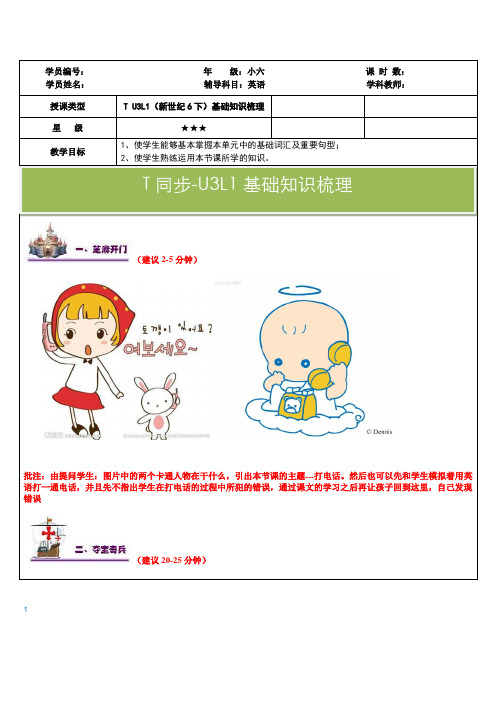
学员编号:年级:小六课时数:学员姓名:辅导科目:英语学科教师:授课类型T U3L1(新世纪6下)基础知识梳理星级★★★教学目标1、使学生能够基本掌握本单元中的基础词汇及重要句型;2、使学生熟练运用本节课所学的知识。
(建议2-5分钟)批注:由提问学生:图片中的两个卡通人物在干什么,引出本节课的主题---打电话。
然后也可以先和学生模拟着用英语打一通电话,并且先不指出学生在打电话的过程中所犯的错误,通过课文的学习之后再让孩子回到这里,自己发现错误(建议20-25分钟)T同步-U3L1基础知识梳理1一、词汇Words1. suppose vt. & vi. 假设;认为【e.g.】I suppose not. 我不认为不是那样的。
I suppose you are right. 我想你是对的。
Let’s suppose (that) the news is true. 让我们假定这消息是真的。
【习惯用语】be supposed to do 被期望或要求做Suppose that 假定批注:让学生联想之前已经学过的think这个词的用语,与suppose相似2. message n. 消息;口信;情报;电报【常用搭配】take a message for sb 捎个口信,转告e.g. I’m sorry, she’s out right now. Can I take a message for you? 对不起,他现在不在,要不要我帮你留话?leave a message (for sb.) 留个话e.g. May I leave a message 我可以留个口信吗?give sb. a message 给某人带口信e.g. Please give Julia a message to say that we shall be late. 请给茱莉亚带个信儿,告诉她我们晚点到。
批注:message 很容易和information和news相混淆,注意message所表示的是口头或书面的某人给某人的“信息”,如果是口头形式,可以解释为“口信”,并且message可数,而information和news不可数。
上海牛津沪教版六年级(下)同步讲义unit1

—-可编辑修改,可打印——别找了你想要的都有!精品教育资料——全册教案,,试卷,教学课件,教学设计等一站式服务——全力满足教学需求,真实规划教学环节最新全面教学资源,打造完美教学模式第一讲Unit1 Great cities in Asia上海牛津沪教版六年级(下)同步讲义Unit1 Great cities in Asia适用学科初中英语适用年级初中六年级适用区域上海课时时长(分钟)120分钟(一对一)知识点知识点1:本单元词汇知识点2:词组知识点3:句型知识点4:how引导的特殊疑问句知识点5:数词的用法教学目标知识:学生能够基本掌握6年级下册Unit1中的词汇、词组、句型及语法。
方法:牢记各个知识点的用法,归纳总结异同点,通过习题加强巩固。
能力:熟练掌握各种词汇的用法;具备准确判断词性及转换的能力;熟练掌握现在完成时的运用能力;熟练运用现在进行时表将来的能力。
教学重点词性转换;how引导的特殊疑问句;数词的用法教学难点how引导的特殊疑问句教学过程一、课堂导入教师讲述一个与本节课题目有关的英文小故事,引出今日所要讲解的知识点,然后让学生简单梳理一下所涉及的问题,带着问题学习本节课的内容。
二、复习预习教师引导学生复习上节课学的重点内容,检测单词的用法,(以提问、回顾的形式进行),针对上节课的作业进行讲评、订正、答疑,并通过英文小故事导入本节课所要学习的新知识。
三、知识讲解1. 知识点一:重点单词1)Asia [ 'eiʃə]【词性】n.【词义】亚洲【易混淆点】Asian 亚洲的;亚洲人【经典例句】Miss Guo and her students are at an exhibition about great cities in Asia.郭女士和她的学生们在一个关于亚洲主要城市的展览会上。
2)Japan [dʒə'pæn]【词性】n.【词义】日本【易混淆点】Japanese 日本的;日本人【经典例句】Tokyo is the capital of Japan.东京是日本的首都。
6Bunit1Thelionandthemouse教案(共五篇)
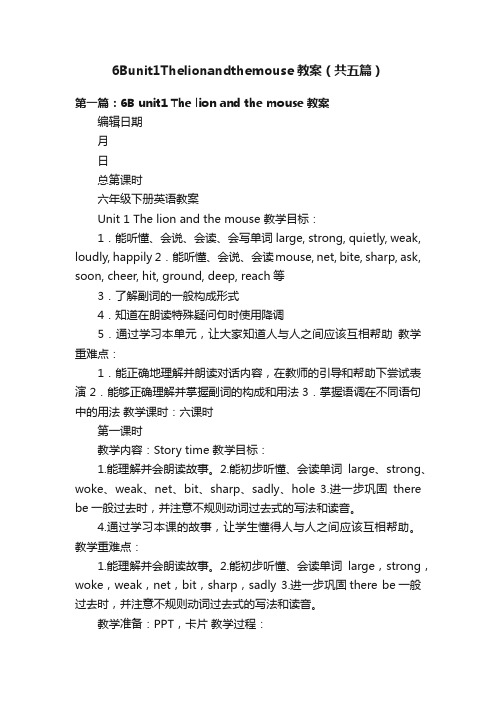
6Bunit1Thelionandthemouse教案(共五篇)第一篇:6B unit1 The lion and the mouse教案编辑日期月日总第课时六年级下册英语教案Unit 1 The lion and the mouse 教学目标:1.能听懂、会说、会读、会写单词large, strong, quietly, weak, loudly, happily 2.能听懂、会说、会读mouse, net, bite, sharp, ask, soon, cheer, hit, ground, deep, reach等3.了解副词的一般构成形式4.知道在朗读特殊疑问句时使用降调5.通过学习本单元,让大家知道人与人之间应该互相帮助教学重难点:1.能正确地理解并朗读对话内容,在教师的引导和帮助下尝试表演 2.能够正确理解并掌握副词的构成和用法 3.掌握语调在不同语句中的用法教学课时:六课时第一课时教学内容:Story time 教学目标:1.能理解并会朗读故事。
2.能初步听懂、会读单词large、strong、woke、weak、net、bit、sharp、sadly、hole3.进一步巩固there be一般过去时,并注意不规则动词过去式的写法和读音。
4.通过学习本课的故事,让学生懂得人与人之间应该互相帮助。
教学重难点:1.能理解并会朗读故事。
2.能初步听懂、会读单词large,strong,woke,weak,net,bit,sharp,sadly3.进一步巩固there be一般过去时,并注意不规则动词过去式的写法和读音。
教学准备:PPT,卡片教学过程:Step 1 Introduction T: hello ,hello, how are you?师唱着hello 歌跟学生打招呼。
My name‟s Mary.Today, I‟m here to make friends with you.Do you want to be my friends? Thank you!So ,my dear friends, can you say something about your new friend? S1: You are great.编辑日期月日总第课时S2: You are beautiful.S3: Your nose is small.S4: You are thin.S5: Your hair is long.2.Review the adjectives.T:I think good friends should do something together.so, let‟s play a game.ok? I say big, and you say “small”.Big---small, long---short, tall---short, cold---hot, new---old, fast---slow, fat----thin, white---black,.strong---thin.(板书 strong---thin)T: Are you strong? Who is strong? Do you know some strong animals? What about these two animals?(Draw a lion and a mouse on the blackboard and talk about them.)引导学生结合板书和简笔画描述狮子和老鼠的外貌。
六年级英语下册 6B Module1 Unit2(4)教案 沪教牛津版
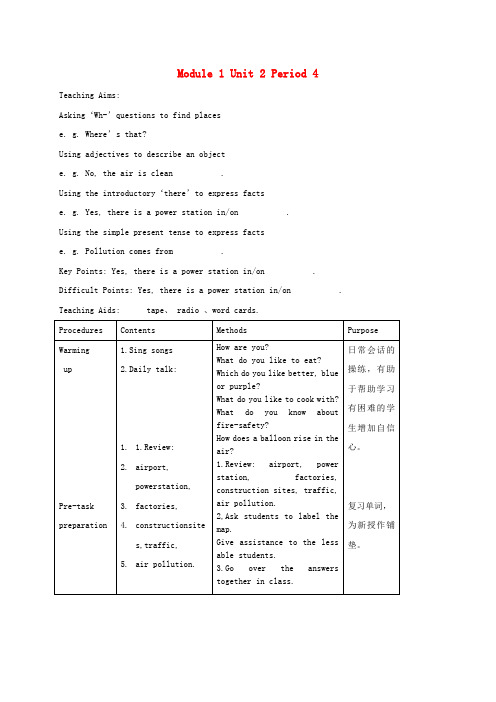
通过讨论,基本了解各district,island的空气污染状况。
练习巩固所学,学习效果好。
交流得出结论,发挥集体智慧。
4.Ask some students to come forward to give answers after being asked questions by the students who are seated.
Read and do pattern drills.
2. Make sentences.
Key Points: Yes, there is a power station in/on .
Difficult Points: Yes, there is a power station in/on .
Teaching Aids:tape、 radio 、word cards.
Procedures
Contents
Methods
Purpose
Warming
up
Pre-task preparation
1.Sing songs
2.Daily talk:
1.1.Review:
2.airport, powerstation,
3.factories,
4.constructionsites,traffic,
Assignment
1.Point, ask and
answer
Exercises
Exercises
1.Ask the students to get into pairs to talk about air pollution in Garden City. Tell them to follow the dialogue in Point, ask and answer.
上海牛津版英语六年级下册6BUnit1U1同步讲义
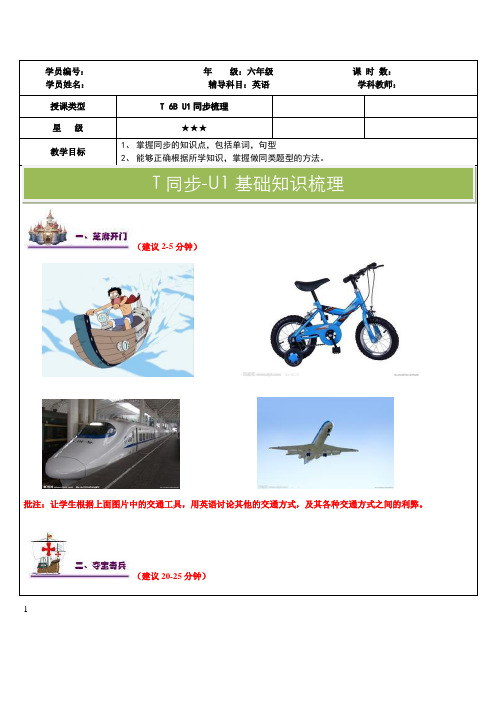
学员编号:年级:六年级课时数:学员姓名:辅导科目:英语学科教师:授课类型T 6B U1同步梳理星级★★★教学目标1、掌握同步的知识点,包括单词,句型2、能够正确根据所学知识,掌握做同类题型的方法。
(建议2-5分钟)批注:让学生根据上面图片中的交通工具,用英语讨论其他的交通方式,及其各种交通方式之间的利弊。
(建议20-25分钟)T同步-U1基础知识梳理1一、词汇Words1. Asia 亚洲e. g. -Where's China on the map? 中国在地图的哪个位置?-It’s in Asia. 中国在亚洲。
【知识拓展】Asian adj.亚洲的,亚洲人【百科小贴士】亚洲是世界第一大洲,它拥有世界上最高的山峰珠穆朗玛峰、最高的高原青藏高原、最深的湖泊贝加尔湖、最大的咸水湖里海和最大的半岛阿拉伯半岛。
批注:成绩好的学生也可以把欧洲,非洲,美洲等知识拓展开来去讲。
2. east (E) adv.在东方e. g. Tokyo is east of Beijing.东京在北京的东方。
【友情提示】E为east的缩写。
又如south(S)在南方,west( W)在西方,north( N)在北方,north-east(NE)在东北方。
注意中英文在表达方位时的差异:汉语说“东北”,但英语说north-east。
又如north-west(NW)在西北方,south-east( SE)在东南方,south-west( SW)在西南方。
用英语表达方位时,我们可以这样记忆:“南北在前,短横在中,东西在后”。
e. g. Bangkok is south-west of Shanghai.曼谷在上海的西南方。
注:North China: 华北批注:news 这个单词的由来,就是由north, east, west, south 这四个词组成的,可以和学生就这个单词把东西南北这四个词都进行联想记忆。
3. exhibition n. 展览会;展览品e. g. They are coming to the exhibition as my guests. 他们作为我邀请的客人来参观展览会。
六年级英语下册第一单元6b教案.docx
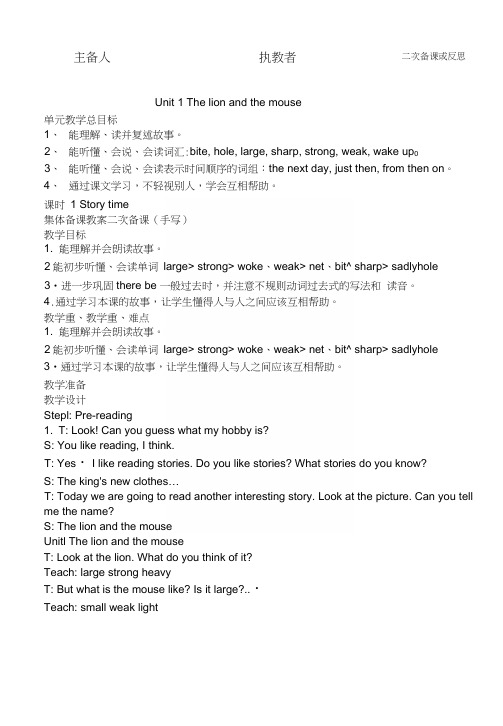
主备人执教者二次备课或反思Unit 1 The lion and the mouse单元教学总目标1、能理解、读并复述故事。
2、能听懂、会说、会读词汇:bite, hole, large, sharp, strong, weak, wake up03、能听懂、会说、会读表示时间顺序的词组:the next day, just then, from then on。
4、通过课文学习,不轻视别人,学会互相帮助。
课时1 Story time集体备课教案二次备课(手写)教学目标1. 能理解并会朗读故事。
2能初步听懂、会读单词large> strong> woke、weak> net、bit^ sharp> sadlyhole3•进一步巩固there be 一般过去时,并注意不规则动词过去式的写法和读音。
4.通过学习本课的故事,让学生懂得人与人之间应该互相帮助。
教学重、教学重、难点1. 能理解并会朗读故事。
2能初步听懂、会读单词large> strong> woke、weak> net、bit^ sharp> sadlyhole3•通过学习本课的故事,让学生懂得人与人之间应该互相帮助。
教学准备教学设计Stepl: Pre-reading1. T: Look! Can you guess what my hobby is?S: You like reading, I think.T: Yes・ I like reading stories. Do you like stories? What stories do you know?S: The king's new clothes…T: Today we are going to read another interesting story. Look at the picture. Can you tell me the name?S: The lion and the mouseUnitl The lion and the mouseT: Look at the lion. What do you think of it?Teach: large strong heavyT: But what is the mouse like? Is it large?..・Teach: small weak lightStep2: While-reading1 .T: The large and strong lion, the small and weak mouse・ What is the story about?First, we know who.What else would you like to know about the story?S: Where? When? What? How?Where? in the forest2. T: What happened? There are some sentences for you. Lefs read them together.The lion caught the mouse but let it go.The lion and the mouse became good friends.The lion could not get out from the net.The mouse helped the lion get out.The mouse woke the lion up.3. Read and match4. Watch and order5. Read and thinkTeach: one day, the next day, just then, from then on6. R ead and thinkQ: Why did the lion let the mouse go?Q: What happened to the lion?Q: How did the mouse help the lion?Picturel &2Pic2: How did the mouse say to the lion. QuietlyHow did the lion say to the mouse? LoudlyThe mouse was afraid・Picture 3-5Underline the new words and phrasesTeach: bite—bit holeHow? Sadly happily7. T: If you were the mouse・ What would you say?1 am small and weak,but 1 am clever and brave(勇敢).1 can help the lion!Step3: Post-reading1. Lefs read.2. Try to retell.3. T: What do you learn from the story?Sometimes, the strong can be weak.再高的人也有屈身的时候,Sometimes, the weak can be strong.M矮的人也有垫脚的时候。
六年级英语下册Unit1《GreatcitiesinAsia》教案牛津上海版(一起)
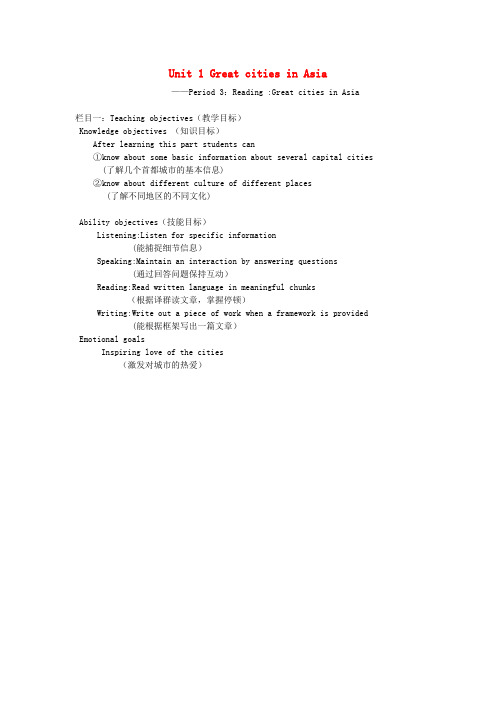
Unit 1 Great cities in Asia——Period 3:Reading :Great cities in Asia栏目一:Teaching objectives(教学目标)Knowledge objectives (知识目标)After learning this part students can①know about some basic information about several capital cities(了解几个首都城市的基本信息)②know about different culture of different places(了解不同地区的不同文化)Ability objectives(技能目标)Listening:Listen for specific information(能捕捉细节信息)Speaking:Maintain an interaction by answering questions(通过回答问题保持互动)Reading:Read written language in meaningful chunks(根据译群读文章,掌握停顿)Writing:Write out a piece of work when a framework is provided(能根据框架写出一篇文章)Emotional goalsInspiring love of the cities(激发对城市的热爱)栏目二:Teaching contentsVocabulary: capital, tourist,Phrase :love/enjoy/like doingSentence pattern(Grammar)there be 句型的运用栏目三:Teaching processReviewComplete the dialogue according to the Chinese.A:How Far is it from Shanghai to Beijing?B: ①(大约1400公里远)A:How can we travel to Beijing?B:we can travel to train.A:②(坐火车从北京到上海要多长时间呢?)B:It takes about 10 hours答案:①It is about 1,400 kilometers.②How long does it take to travel from Shanghai to Beijing by train?Lead-inReadingN①Beijing②Tokyo上海W E③BangkokSMore exploration①Beijing is the capital of China. It is north of shanghai.you can find museums, palaces and parks there. Many tourists like visiting those places. They always visit the great wall.there are more than 15 million people in Beijing.they enjoy eating dumplings.Practice 1:Find the key points :①the capital of China②it has many view③large amount of populationPractice 2:Retell the general idea according to key points.②Tokyo is the capital of japan. It is north-east of shanghai.you can see a lot of tall buildings, huge department stores and famous hotels there.tourists usually go shopping in Tokyo. There are about 12 million people in this city. They love eating sushi.Practice 1: Find the key points :①the capital of Japan②big modernized city③busy businessPractice 2:Retell the general idea according to key points.③Bangkok is the capital of Thailand. It is south-west of Shanghai. There are many temples and beaches in Bangkok. A lot of tourists enjoy swimming in the sea at these beautiful beaches. There are about 8 million people in Bangkok. They love eating fruit. They also love eating spicy food.Practice 1: Find the key points :①the capital of Thailand② typical tropical view③ many kinds of foodsPractice 2:Retell the general idea according to key points.栏目四:Summary...is the capital of ...:某地是哪个地方的首都/首府It is south-west/north-east... of ...:它位于某地的西南/东北等等 ...love/enjoy/like doing ... 某人或某物喜欢做某事Eg: London is the capital of the UK, it is north-west of Shanghai.伦敦是英国的首都,它位于上海的西北方。
上海新世纪版英语六年级下册6BUnit1Lesson2U1L2同步讲义教案
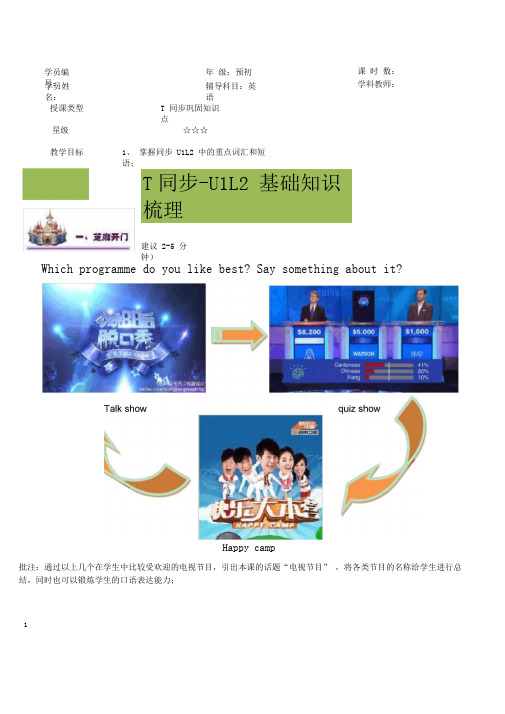
1Which programme do you like best? Say something about it?Happy camp批注:通过以上几个在学生中比较受欢迎的电视节目,引出本课的话题“电视节目” ,将各类节目的名称给学生进行总 结,同时也可以锻炼学生的口语表达能力;学员编号: 年 级:预初学员姓名:辅导科目:英语课 时 数: 学科教师:授课类型 T 同步巩固知识点星级 ☆☆☆教学目标1、 掌握同步 U1L2 中的重点词汇和短语;T 同步-U1L2 基础知识梳理建议 2-5 分钟)2一、词汇 Words1. programme n. 节目,节目单 ( 也作 : program ) 辨析 : performance programmeperformance 是 “表演,表现 ”,常指舞台上 的演出。
programme 主要是指电台或电视节目或电脑程序等。
e. g. ) I like to watch TV programmes after supper. 我喜欢晚饭后看电视节目。
We put on English performances at the English Evening. 我们在英语晚会上表演了英语节目。
批注:两个词的词形很像,因此容易搞混,要注意含义区分,同时 TV programmes 在选择题目中常考,一般以复数 为主;e. g. This is a special day in the history of our country. 今天是我国历史上一个特殊的日子。
The mushroom is a speciality here. 蘑菇是这里的特色菜。
I made this specially for your birthday. 这是我特意为你生日而作的。
批注:注意 special 的几个词形变换,在词转题目中还是很常考的,尤其是 specialist 4. stay vi. & n. 逗留,暂住 (过去式; stayed 现在分词: staying ) e. g. He was staying at theRitz(Hotel).她住在里兹旅馆3. special a. 特别的,特殊的,专门的 派生词 : specially ad . 特别地,专门地speciality n. 特长,专长,特色菜specialist n. 专家quiz kid 极聪明的孩子 批注: [ 复 ]quizzes 需要注意一下是加 -es ;建议 20-25 分钟)2. quiz n. 测验,考查习惯用语 :have a quiz (进行)小测验 quiz show (电视, 电台的 )智力竞赛节目quizmaster (答问比赛节目中的)提问者习惯用语 : stay in 呆在家里 = stay at home— stay home保持stay here/there 呆在这、那stay+adj.stay up 不睡,熬夜stay behind 留下来34send ⋯ for 派人去拿,派人去请send sb. sth. = send sth. to sb. 寄某物给某人e. g. He send me a card( = He sent a card to me). 他寄给我一张卡。
沪教版小学六年级下册英语教案

【导语】英语教案设计是改善课堂教学的⼀种更⾼层次的探索,是提⾼课堂教学质量和效率的⼀项必要⼯作,它可以促进教学的系统化,使⽼师掌握讲课节奏。
以下是®⽆忧考⽹整理的《沪教版⼩学六年级下册英语教案》相关资料,希望帮助到您。
【篇⼀】沪教版⼩学六年级下册英语教案 ⼀、教学内容: 综合练习 ⼆、教学⽬标: 1、掌握形容词以及⽐较级的使⽤。
2、能听得懂、会说、会读和会拼写tall ,light ,young ,old ,heavy。
3、掌握会话中出现的三会单词和词组twin ,minute ,centimeter, child ,cute, also, chat. 4、能听得懂、会说、会读和会写四会句型:Who taller than David? Gao Shan is taller than David . 5、能听得懂、会说、会读⽇常交际⽤语. Whose bag is heavier ,yours or mine ? I'm as tall as you . SuYang is younger than Su Hai . 6、了解字母组合or在单词中的读⾳。
7、会说英语歌谣《Iwish Iwas taller.》 三、教学重、难点: 正确掌握B部分出现的四会单词light lighter , heavy heavier,和句型Who is taller ,you and SuYang? Whose ruler is longer ,yours or mine? 四、课前准备: 1、准备录⾳机和本课H部分的磁带 2 、练习题的投影⽚。
3 、课前写好本课的课题。
五、教学过程: A、跟⾳乐集体唱歌曲。
B、 1、Free talk. 师⽣交流 2、请学⽣之间⽤所学的句型问答,分组⽐赛 C、Revision 复习 1、看A部分投影⽚,创设情景让学⽣表演 2、让学⽣复述A部分第⼀段和会话。
上海新世纪版英语六年级下册6BUnit1U1总复习同步讲义教案

学员编号:年级:小六课时数: 学员姓名:辅导科目:英语学科教师:一,第席开门(建议2-5分钟)批注:以上四幅图为旅游景点,一次四幅图作为引入与课本内容相符。
(建议20-25分钟)1. Asia n.亚洲I【知识拓展】Asian n.亚洲人adj.亚洲的2.east (E) n.东方adv.在东方【知识拓展】west(W)西方north(N)北方south(S)南方north-east(NE)东北方north-west ( NW)西北方south-east(SE)东南方south-west(SW)西南方3.exhibition n.展览会;展览品【知识拓展】exhibit v.展示或展出1.1nformation n. 信息【知识拓展】同义词:news注意:以上两个名词都是不可数名词5.tourist n.游客;观光者【知识拓展】tour n.旅游,旅行6.building n.建筑物【知识拓展】build v.建造7.famous adj.著名的【知识拓展】be famous for , be famous as的区别(1)be famous for后所接的宾语是表原因的(for后的宾语是主语的所属)(2)be famous as后所接的宾语是表结果(as后的宾语是主语的同位语)批注:因为是复习课,所以词汇的复习课采用挖空的形式,让学生去填写,这样复习的效果比较好。
重点句型:1.How far is it from Shanghai to Beijing?2.How long does it take to travel from Shanghai to Beijing by train.3.In the past, people travelled to other places by ship.“by+交通工具”表示"乘.....(交通工具)"注意在此结构中,交通工具前不加冠词a/an/thee.g : by bus/train/ship/underground【友情提示】课文中的by plane相当于by air, by ship相当于by sea.表示步行可用on foot.询问"乘.....(交通工具)",用how提问【知识拓展】表示"乘.....(交通工具)"还可以用"take + a/an交通工具”但是和“by +交通工具”所放的位置不同e.g : Tom goes to school by bus.= Tom takes a bus to school批注:在复习重点句型的时候可让学生翻译句子,老师说中文,学生说英文。
牛津上海版六年级下册U1教案

(2)所属关系:A is in the north of B.
(3)两地接壤:A is on the north of B.
P3 by+交通工具 表示乘....(交通工具),用 How 提问
1. How far is it from Shanghai to Beijing?从北京到上海有多远?
3
How far... 多远。询问距离的远近,路程的长远。
read → reading 读 talk → talking 谈 话 ep---sleeping
speak---speaking
2. 不发音的-e 结尾的动词去掉 e 后再加-ing:
smile → smiling 微 笑 move → moving write → writing 写 wake---waking
2.How long does it take to travel from Shanghai to Beijing by
train?
坐火车从上海到北京要多久?
(1)How long...多久。询问时间长短。(对 for/about+一段时间提问)
(2) How long…多长。用于询物的问长度。
3.How soon will you go back? 你要多久回来 How soon 多久 ,询问时间长短 (对 in+一段时间提问) from...to...从...到... Half an hour one and a half hours=one/an hour and a half 一个
A. What B. Which C. Where D. This
( ) 3. Russia is ___________ China.
六年级英语下册Unit1GreatcitiesinAsia教案牛津版上海版
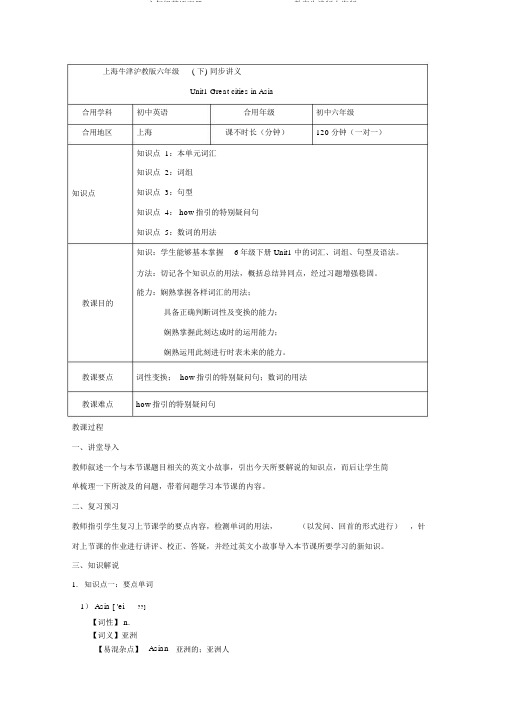
上海牛津沪教版六年级( 下) 同步讲义Unit1 Great cities in Asia合用学科合用地区知识点初中英语合用年级初中六年级上海课不时长(分钟)120 分钟(一对一)知识点 1:本单元词汇知识点 2:词组知识点 3:句型知识点 4: how指引的特别疑问句知识点 5:数词的用法知识:学生能够基本掌握6年级下册 Unit1 中的词汇、词组、句型及语法。
方法:切记各个知识点的用法,概括总结异同点,经过习题增强稳固。
能力:娴熟掌握各样词汇的用法;教课目的具备正确判断词性及变换的能力;娴熟掌握此刻达成时的运用能力;娴熟运用此刻进行时表未来的能力。
教课要点词性变换; how指引的特别疑问句;数词的用法教课难点how指引的特别疑问句教课过程一、讲堂导入教师叙述一个与本节课题目相关的英文小故事,引出今天所要解说的知识点,而后让学生简单梳理一下所波及的问题,带着问题学习本节课的内容。
二、复习预习教师指引学生复习上节课学的要点内容,检测单词的用法,(以发问、回首的形式进行),针对上节课的作业进行讲评、校正、答疑,并经过英文小故事导入本节课所要学习的新知识。
三、知识解说1.知识点一:要点单词1) Asia [ 'ei??]【词性】 n.【词义】亚洲【易混杂点】Asian亚洲的;亚洲人【经典例句】Miss Guo and her students are at an exhibition about great cities in Asia.郭女士和她的学生们在一个对于亚洲主要城市的博览会上。
2) Japan [d ??' p?n]【词性】 n.【词义】日本【易混杂点】 Japanese 日本的;日自己【经典例句】Tokyo is the capital of Japan.东京是日本的国都。
3 ) Thailand[ 'tail?nd【词性】 n.【词义】泰国【易混杂点】 Thai【经典例句】]泰国的;泰国人Bangkok is the capital of Thailand.曼谷是泰国的国都。
- 1、下载文档前请自行甄别文档内容的完整性,平台不提供额外的编辑、内容补充、找答案等附加服务。
- 2、"仅部分预览"的文档,不可在线预览部分如存在完整性等问题,可反馈申请退款(可完整预览的文档不适用该条件!)。
- 3、如文档侵犯您的权益,请联系客服反馈,我们会尽快为您处理(人工客服工作时间:9:00-18:30)。
学员编号:年级:预初课时数:学员姓名:辅导科目:英语学科教师:授课类型T 同步巩固知识点星级☆☆☆教学目标1、掌握同步U1L1中的重点词汇和短语;2、T同步-U1L1基础知识梳理(建议2-5分钟)你喜欢什么运动呢?能用英语表达一下吗?running/jogging swimming skating批注:本单元的中心是运动,可以通过图片来激发学生的兴趣,让学生自己来谈谈喜欢的运动,还可以练习一下学生飞口语表达能力;另外所有关于运动的一些词汇可以给学生进行系统的总结,以及运动前面的冠词的搭配使用,使学生有一个系统的认识;(建议20-25分钟)一、词汇Words1. jog vi. 慢跑(现在分词jogging 过去式jogged)e. g. Every morning he likes jogging。
每天早晨他都喜欢慢跑。
习惯用语: go jogging 慢跑1bowl vi. 打保龄球;n. 碗e. g. Do you want to go bowling with us? 你要不要和我们一起去打保龄球?John is good at bowling. 约翰保龄球打得不错。
I'd like a bowl of tomato soup, please. 请给我来碗西红柿汤。
批注:运动类的词汇注意固定搭配go doing 形式,在选择题目总常考;2. golf n. 高尔夫球运动e. g. Let's play a round of golf. 我们打一场高尔夫球吧。
习惯用语:play golf 打高尔夫chess n. 棋,国际象棋。
习惯用语:play chess 下象棋批注:注意两个固定搭配中没有冠词the,在选择题目中是常考点;3. badminton n. 羽毛球习惯用语:play badminton批注:注意球类的词前面是没有冠词的,可以再给学生扩展一下其他的同类词;4. break n. 休息,暂停习惯用语:have a break=have a rest 休息一下during the break 在休息期间vt. 打破,打断(过去式broke)e. g. I broke my leg yesterday. 昨天我的腿摔坏了。
5. yourself pron. 你自己[复]yourselves 你们自己(常用于固定搭配词组中)(已学的反身代词还有himself,反身代词在句中应与主语人称保持一致)习惯用语::enjoy yourself/yourselves=have a good time 祝你(你们)玩得开心e. g. Jack enjoyed himself in Hainan. 杰克在海南过得很愉快。
=Jack had a good time in Hainan,help yourself/yourselves to sth. 请随便吃......e. g. Help yourself to some tea,Mary. 玛丽请随便喝茶。
Help yourselves to the fruit, children, 孩子们请随便吃水果。
批注:反身代词的第一个固定搭配是在同义句中的常考点;第二个搭配是词义的掌握,学生会对这个短语的词义掌握的有偏差;6. team n. 队;组习惯用语: football team 足球队on the team 在球队(踢球,参加比赛等)team sports 团体运动teamwork 团队合作team spirit 团队精神team mate 队友2e. g. He is the best player on the team. 他是队里最出色的选手。
There are eleven players in a football team. 一个足球队里有十一个队员。
7. no wonder 难怪;不足为奇e. g. You're from Sichuan. No wonder you like hot food.Wonder n. 奇迹;惊奇e. g. What a wonder! 好奇怪啊!There was a look of wonder in his eyes. 他眼中露出惊奇的神色。
批注:固定搭配,主要掌握含义即可,选择题目中的交际用语常考点;8. active a. 积极的;活跃的;主动的习惯用语:take an active part in... 积极参加...... 活动=join in... activelybe active in... 在积极active voice 主动语态e. g. He is active in work. 他积极工作。
The lady is active in helping others. 这个女士积极帮助别人。
批注:这个词的此行变换的知识点很多,要将每个词形记忆清楚;actively ad. 积极地activity n. 活动act v. 表演,行动action n. 行动actor n. (男) 演员actress n. 女演员9. twice ad. 两次;两倍once 一次three times 三次习惯用语:twice a week 一周两次批注:表示频率,用how often 对频率提问;how long, how soon 等疑问词的用法可以进行区分一下;10. spend vt, 花费(过去式spent )习惯用语: spend (money) on sth. 花钱买某物e. g. I spend 50 yuan on books every month. 我每月花50元买书。
spend (time) in doing sth. 花时间做某事(in可以省略)e. g. She spent 20 minutes(in) playing badminton. 她花了20分钟打羽毛球。
批注:辨析: spend, take这两个词都表示“花费”,但用于不同的句型。
It takes sb. some time to do sth.sb. spend some time (in) doing sth. / sb. spend (money) on sth.take 只能用于花费时间,,而spend 既能用于花费时间也能用于花费金钱。
11. kind n. 种;类习惯用语a kind of 一种all kinds of 各种= different kinds ofkind of 稍微有点(口语) this kind of 这种e. g. What kind of game do you like to watch best? 你最喜欢观看哪种运动的比赛?We often do this kind of exercise(exercise of this kind). 我们经常做这类练习。
adj. 和蔼的,仁慈的= friendly, good to other people3e. g. You should be kind to animals, and not hurt them.It was very kind of you to help me. 您这样帮助我真是太好了。
批注:派生词:kindness n. 好意kindly ad. 温和地,亲切地12. bridge n. 桥,桥牌e. g. ) a bridge across the river 架在河上的桥习惯用语:play bridge 打桥牌批注:注意固定搭配中是没有冠词the的;二、重要句型Important Sentences structures1. take part in 参加= join in辨析:join, join in, take part injoin意为“加入某一组织、党派或社会团体,从而成为其成员”(become a member of)".e. g. He joined the singing group last year. 去年他加入了歌唱小组。
Won't you join us in a football match? 你不想参加我们的足球赛吗?join in 与take part in都表示“参加”。
join in多指参加正在进行的竞赛、娱乐、谈话等活动,其后只能接表示活动的名词,不可接动名词;而take part in指参加群众性活动或会议,并在其中起一定作用。
e. g. ) Would you like to join in the sports meeting? 你想参加运动会吗?We took part in the evening party last week. 上周我们参加了一次晚会。
批注:join常出现的搭配是join us; join singing group;take part in 常出现的搭配:take part in activity; take part in sports meeting; take part in group singing(注意和singing group 进行区分);2. so conj. 所以,因此( e. g.) The shop is closed, so I can't buy the bread. 商店关门了,所以我不能买面包。
(so 和because 不能同时使用) ad. 如此,那么(e. g. ) I hope so. 我希望如此。
The bag is so heavy that I can't carry it. 这个袋子太重了,我拿不动。
批注:辨析:so, such 都有“如此......”,“这么......”之意,但两个单词的词性不同:such为形容词,意思是“”这(那)样的,修饰名词。
so为副词,修饰形容词和副词。
e. g. so lovely 如此可爱such a lovely girl 如此可爱的女孩用于单数名词前时,such和so的位置不同,即"such +a/an+形容词+ 单数名词”和“so+形容词+a/an+单数名词"结构。
e. g. so kind a girl=such a kind girl 如此善良的女孩3. like的用法:4(1)like doing sth. / to do sth. 喜欢做某事= enjoy doing sth.(2)would like to do sth. 想要做某事= want to do sth.批注:第二个句型在同义句中时常出现的考点,并且want to do sth. 一定要注意人称的三单用法;4.区别: interesting 和interestedinteresting 有趣的(令人感兴趣的)e. g. ) an interesting film 一部有趣的电影an interesting story 一个有趣的故事interested 感兴趣的(感到感兴趣的)be interested in... 对感兴趣(e. g.) A:I'm interested in maths. —我对数学感兴趣。
